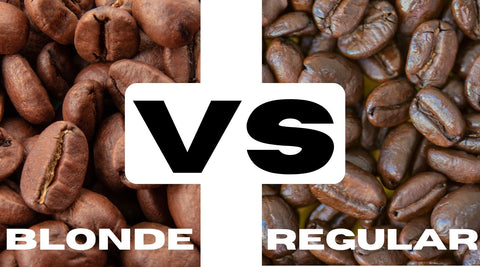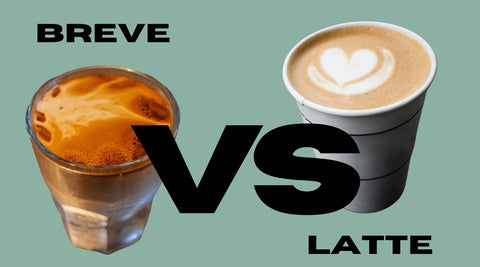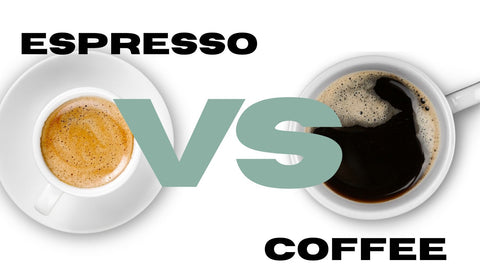If you’ve ever been to Starbucks, you probably noticed that you can order coffee drinks made with Starbucks blonde espresso roast instead of regular espresso. A nice example is a blonde vanilla latte (where the blonde roast’s reduced bitterness really shines).
But what's the difference, and would you order a blonde espresso beans? This pretty much depends on your preferences regarding coffee drinks.
If you want to be able to answer this question, you’ll need to understand what a blonde espresso is and how it differs from a regular espresso.
In this article, we’ll look at blond and regular espresso to help you make a decision on which you might like better. The next time you want to buy some coffee beans for your home or stand in front of a coffee shop’s espresso machines, you’ll know exactly what to order.
What Is Blonde Espresso?
The blonde espresso was initially also called “cinnamon roast”.
The name didn’t stick around for long because people tended to be confused about it. They expected it to taste like cinnamon, but all the name described was the color of the roasted coffee beans and coffee grounds - not the actual taste!
So, What’s Blonde Espresso, and What Type of Beans Are Used for It?
It's fairly simple: Unlike regular espresso, usually made with a darker roast, blonde espresso is made with lightly roasted coffee beans. The result is a milder and more delicate flavor profile with more fruity notes, some floral undertones, a bright acidity, and a lighter body.
Who and What Is Blonde Espresso Suitable For?
A blonde espresso is a great choice for people who don't enjoy the bitterness of darker roasts. Blonde roasts also work very well as a base for drinks where other flavors come into play, like lattes.
A blonde espresso is more subtle and will blend well with flavors like vanilla, chocolate, and caramel.
It also works nicely for a mochachino, as the lack of bitterness from the coffee will add a nice balance to the cacao's natural bitterness.
Is Blonde Espresso Stronger?
Blonde and regular espresso beans both pack a punch, but blonde espresso isn't stronger. Dark roast coffee beans generally produce a bolder and richer espresso, though a blonde espresso has a tiny bit more caffeine!
Why is Blonde Espresso so Popular?
We mentioned Starbucks above, but that's not because we prefer Starbucks over others. Starbucks simply is the main reason why blonde espressos (and many other coffee drinks) have gained so much popularity over the last dozen years.
The coffee shop chain introduced its blonde roast espresso as a menu option in 2013, and since then, other shops and many coffee lovers started appreciating this different type of espresso. If you love a good blonde roast, you can try our Adrenaline Junkie (also as a ground coffee if you have no grinder at home).
What Is Regular Espresso?
Regular espresso or normal espresso is what people usually talk about when they say "espresso". It's a strong coffee you get from espresso machines that force hot water through fine coffee grounds with high pressure (getting the pressure right is its own art).
The Flavor Profile of Dark Roasts
A normal espresso has a strong, bold flavor and a full body with less acidity than a blonde espresso. Instead of fruity notes, you get chocolatey, nutty, and caramel notes in a regular espresso’s flavor profile. You can still get some fruity notes, but usually only in the form of very subtle hints.
Regular espresso is made from dark-roasted coffee beans (which means the beans are roasted longer than a light and medium roast).
In most cafes, regular espresso is the only option you get as a base for coffee drinks like lattes, cappuccinos, Americanos, etc. Of course, you can also just drink a shot on its own as a nice pick-me-up.
Comparing Blonde Espresso vs Regular Espresso Beans
Caffeine Levels
Blonde espressos do have higher levels of caffeine than regular espresso, but in general, the caffeine levels in blonde espresso and regular espresso aren't that different.
Various studies (like Influence of Various Factors on Caffeine Content in Coffee Brews - PubMed (nih.gov)) have shown that the difference is negligible.
There are many strange beliefs about caffeine content, and we won't repeat these here.
What you need to know is that how much caffeine is in a cup depends on the bean itself, not the roast level. If you want more caffeine, choose a bean known for its higher caffeine content.
Bean Origin
While you can use beans from any origin to make blonde or regular espressos, there are generally some origins that are more popular choices.
Lightly roasted coffee beans for blonde espresso often come from regions famous for bright and nuanced flavors.
Some popular origins for blonde espresso are:
-
Latin American countries like Costa Rica, Colombia, and Guatemala.
-
East African coffee beans from countries like Ethiopia and Kenya
Some specialty roasters also experiment with blends to create a distinct flavor.
Suppose you're interested in home-roasting your own blonde espresso. In that case, you'd ideally choose an origin that's known for coffees that have fruity flavor profiles, as a light roast is perfect for these kinds of beans (a lighter roast level preserves the unique characteristics of these beans).
Dark roasted espresso beans are often from regions that produce beans that can withstand the longer roasting process without losing their flavor identity. You’ll usually find that these beans tend to be on the chocolatey side.
Common origins for regular espresso are:
-
South American countries like Brazil and Peru
-
Indonesian regions like Sumatra
Roast Level
Blonde espresso is made from coffee beans that are roasted for a shorter duration, typically around 9-11 minutes. The result is a lighter-colored bean with a more delicate and brighter flavor profile (remember the name "cinnamon roast"? That kind of color).
On the other hand, regular espresso is made from dark roasted coffee beans, which are roasted for a longer duration, around 12-15 minutes. These beans have a darker color and a bolder, richer, and sometimes slightly bitter flavor profile (which depends greatly on the beans' origin and processing method).
Taste
While the roast level doesn't make a huge difference regarding caffeine content, it does make a difference regarding flavor and aroma. Darker roasts generally have a bolder and more robust flavor with a fuller body. You'll usually find chocolate (or cacao), nuts, and caramel as part of their flavor profiles.
A blonde espresso, on the other hand, is made from lightly roasted beans. These tend to have a milder, brighter, and more delicate flavor profile with a lighter body, fruity notes, and sometimes floral hints.
Acidity Levels
While longer roast time neither burns off caffeine or calories, it’s a different story regarding acidity levels. We’ll keep it simple here because the process is fairly complex.
The short of it is that a blonde espresso has a higher acidity compared to regular espresso because, during the roasting process, acidity is reduced over time. A blonde espresso's acidity is bright and slightly tangy.
A regular espresso is made from beans that have been roasted for a longer time. While this gives you a richer coffee, it also gives you a less acidic one. A dark roast has a “mellow” acidity and brings out more pronounced bitter and chocolatey flavors.
Final Thoughts
While the Starbucks blonde espresso is what started the popularity of blonde espresso, coffee enthusiasts can buy blonde espresso in many places these days - not just in your local Starbucks. A nice variety of blonde espresso offers can be found in specialty coffee shops and can also be ordered from our website.
Ultimately, which one you prefer depends on whether you like rich and bitter coffee or coffee with a brighter acidity and less bitterness. It's also fine to love both options for their benefits: e.g., a blonde espresso for your coconut latte and a regular espresso for a delightful double-shot cappuccino.
FAQ
Is Blonde espresso healthier?
Many coffee lovers wonder whether a blonde espresso is healthier than regular coffee or normal espresso. When you look at the difference between blond and regular espresso, you’ll not notice a huge one. The differences in caffeine content, for example, are just not significant enough to make a difference.
Overall, blonde espresso is just as healthy as normal espresso if you don’t drink too much of it (coffee has been linked to numerous health benefits, but only if you don’t have your espresso machine running nonstop!).
Blond Espresso Vs Regular Espresso Calorie Difference?
Blonde espresso shots do not have fewer calories than regular espresso shots. One shot of blonde espresso has 2-5 calories. In comparison, a regular espresso shot also has around 2-5 calories.
Considering that 2-5 calories don't ruin anyone's diet, what you add to your blonde and regular espresso shot is more of a concern if you're calorie counting!
Even steamed milk will add lots of calories. If you're concerned about your calorie intake, change the milk you use, add less sugar to your coffee, and avoid the sweet syrups so many coffee drinkers love.
Do You Need Different Equipment or Brewing Methods for Regular and Blonde Espresso?
No, you don't need two different machines. If you have a good espresso machine at home, you'll have no problem brewing regular and blonde.
The process is the same for both types, so there's no need to buy more expensive equipment. If you don't have an espresso machine at home, you can also use a French press. The result won't be perfect, but you can still make some great espresso-based drinks at home.



